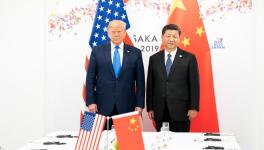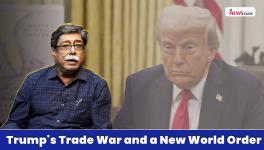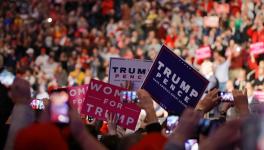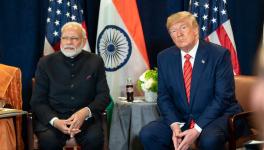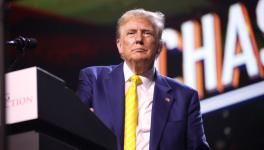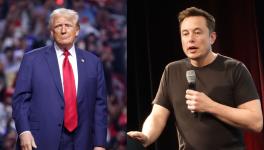The Strategic Myopia of Trump’s Trade War
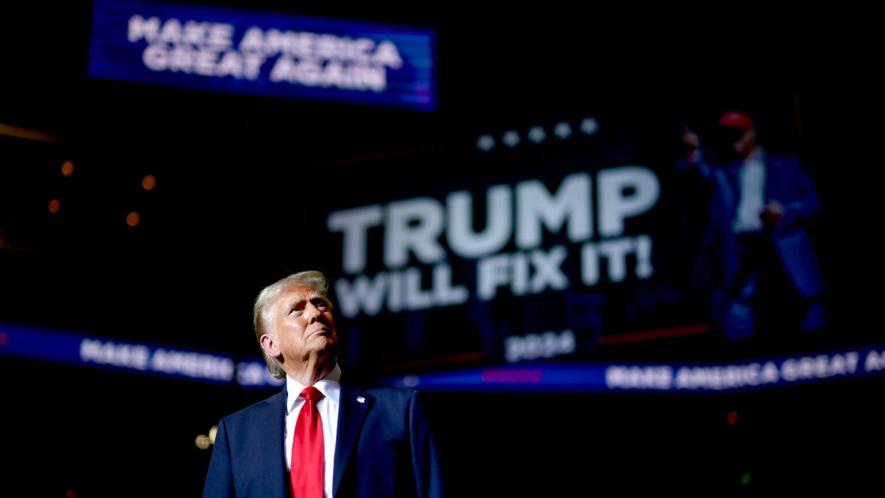
Photo via @realDonaldTrump/X
The so-called Liberation Day tariffs imposed by US President Donald Trump ostensibly aim to reduce the US trade deficit and revive manufacturing in the economy. However, these measures reflect a fundamental misunderstanding of the international political economy and the United States’ position within it. Let us examine why.
To begin with, the US government has imposed a 10% tariff on all imports, alongside higher tariffs on specific countries, purportedly to reduce its trade deficit with them. The ideological transmission of this tariff war is furthered by the usage of the phrase “reciprocal tariffs” whereby the US is ostensibly responding to tariffs on the part of other countries. But this is unlikely to have much purchase at present.
However, given the concrete array of forces in the contemporary international political economy, the differential tariff war seems to be effectively a tactic to prevent the emergence of a multilateral opposition. Instead, the Trump administration seeks to induce other countries, especially those on whom relatively low tariff rates have been imposed, to engage in bilateral negotiations, which it is hoped will weaken any multilateral opposition.
Therefore, it is not surprising that the US Treasury Secretary has disingenuously argued that other countries should refrain from retaliating against these tariffs, warning that retaliation would provoke further escalation from the Trump administration.
What makes this tariff war even more questionable is the fabricated methodology used to calculate these so-called “tariff rates.” Interestingly, these figures were not derived from actual data on tariff and non-tariff barriers. Instead, the Trump administration simply divided the US trade deficit with each country by the value of that country’s exports to the US, producing inflated and misleading numbers.
This approach gave the impression that countries like South Korea and the European Union (EU) were imposing tariffs of 50% or more on US exports—despite existing trade agreements that clearly contradict such claims. These misleading figures were then used to justify the imposition of punitive tariffs, further demonstrating the rhetorical rather than empirical basis of the administration’s strategy.
Assuming other countries do not retaliate initially, how are these tariffs expected to function? Basic political economy reasoning suggests that tariffs raise the price of imported goods in the US, incentivising domestic producers who were previously unable to compete with foreign rivals to initiate or expand production of these commodities.
Yet this expectation is flawed for several reasons.
First, the assumption that US firms can produce goods at competitive prices post-tariffs, relies on dubious premises. The US imports numerous production inputs, and tariffs on these inputs will raise domestic production costs. Consequently, the ability of US firms to achieve profit rates deemed sufficient to justify new or expanded production may not improve. Instead, domestic firms may exploit higher import prices by raising their own prices, boosting profit margins but reducing the wage share in the economy. The resultant decline in capacity utilisation could offset any positive impact that higher profit margins may have on private domestic investment.
Second, tariffs elevate the domestic price level. With wages stagnant, the wage share would fall, further depressing capacity utilisation and private investment. Private investment tends to depend on two principal factors: (1) capacity utilisation and (2) the gap between the profit rate and the financial rate of return. A higher price level could prompt the US Federal Reserve to raise interest rates, increasing borrowing costs for firms and raising the floor for financial returns. Both effects would discourage private investment.
Third, US production is deeply integrated with supply chains in Canada and Mexico. Tariffs on these nations would raise costs for US firms, explaining why the current “Liberation Day” tariffs largely exempt them. Notably, the US Senate recently voted to reverse Trump’s tariffs on Canada, with support from four Republican senators.
Fourth, any attempt to use tariff revenue to extend or enhance corporate tax cuts for a given level of the budget deficit in the US will involve a regressive redistribution of income from the working people to monopoly capital in the US. This will have an adverse impact on aggregate consumption and, therefore, on capacity utilisation and private investment.
Retaliation by other countries poses additional risks. Anticipating US tariffs, many nations have prepared retaliatory measures. Such retaliation would reduce US exports, negating any import declines caused by Trump’s tariffs. Moreover, tariffs on imported inputs into the US economy would further reduce the competitiveness of US exports. The net effect on the US trade deficit might thus be negligible or even adverse. Countries with near-monopoly control over certain exports could even impose export duties on goods bound for the US.
Broader implications include threats to the US dollar’s reserve currency status. Reduced use of the dollar in trade (due to tariffs) could undermine its role as a store of value. This is likely to be the case, since the store-of-value role of money and the medium-of-exchange role of money are two sides of the same coin.
Moreover, global production networks may reorganise to further marginalise the US. China’s expanding exports to Global South countries and emerging global production networks, excluding the US, exemplify this trend. Coordination among China, South Korea, and Japan in responding to Trump’s tariffs likely signals a shift toward such an alternative.
Underlying causes of US manufacturing decline stem from neoliberalism’s dual focus on domestic labour precarity (through a differential squeeze on working people) and global production relocation (in activities at the lower and lower-middle reaches of the technological ladder within global production networks), particularly to China and countries in its neighbourhood. China has comprehensively ascended the technological ladder within global production networks, surpassing the US in innovation and emerging as at least a peer rival in invention.
Financialisation, driven by US-centric international finance, exacerbated manufacturing’s decline, enriching US monopoly capital while differentially squeezing working people. The gargantuan levels of profiteering by US monopoly capital in private health and private education involve wages for skilled workers capable of coping with this profiteering too high to ensure an adequate rate of return for enterprise capital in the US.
Infrastructure gaps, wage share disparities, and demand patterns between the US and China have further disadvantaged domestic production. The demolition job by Elon Musk’s DOGE (Department of Government Efficiency), bent on dismantling what is left of the social wage in the US, will further adversely impact efforts to revive US manufacturing.
The Trump administration’s expectation of a manufacturing revival presumes that domestic returns on enterprise will exceed those in finance globally for at least some segments of US monopoly capital. However, measures to boost enterprise returns (e.g., tariffs) simultaneously elevate financial returns via higher interest rates that an inflation-targeting central bank must adhere to. Eschewing inflation targeting by the US Federal Reserve will accelerate the undermining of the dollar’s reserve currency status.
The Trump administration hopes to resolve this conundrum through a Mar-a-Lago Accords, which it envisions as a repeat of the 1980s Plaza Accords, where German and Japanese enterprises were short-circuited by currency appreciation to reduce the US current account deficit without undermining the dollar’s attractiveness as a principal medium of wealth-holding for international finance. However, unlike Germany and Japan in the 1980s, China exercises effective strategic autonomy, ruling out a repeat of the Plaza Accords.
Therefore, Trump’s ‘Liberation Day’ tariff war will fail to spur the anticipated resurgence in US manufacturing. It is more likely to accelerate the ongoing relative decline of the US.
Shirin Akhter is Associate Professor at Zakir Husain Delhi College, University of Delhi. C Saratchand is Professor, Department of Economics, Satyawati College, University of Delhi. The views are personal.
Get the latest reports & analysis with people's perspective on Protests, movements & deep analytical videos, discussions of the current affairs in your Telegram app. Subscribe to NewsClick's Telegram channel & get Real-Time updates on stories, as they get published on our website.










